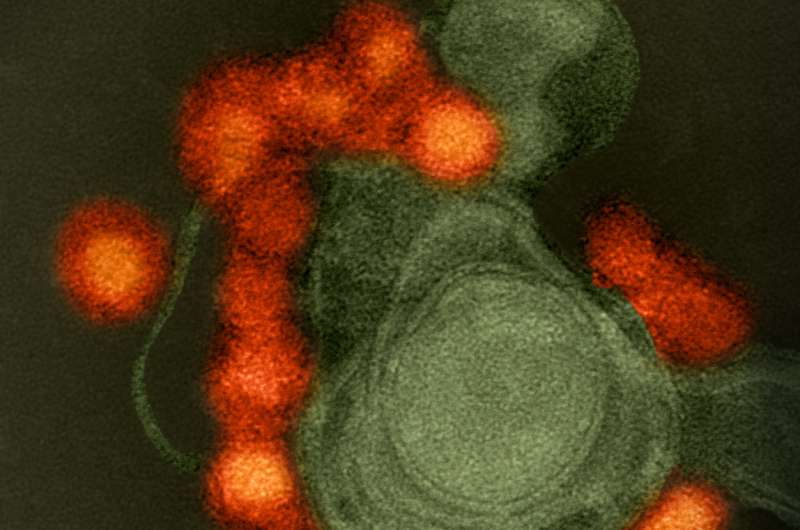Researchers find Zika virus replicates in placental trophoblasts, could have implications for early prenatal diagnosis

Why is there a delay between when a pregnant woman is infected with Zika virus and when her fetus shows signs of brain malformations or microcephaly? Why do only a small minority of infants born to infected women appear to be affected by Zika virus infection? Researchers at Baylor College of Medicine may have found answers to these important questions through their discovery that the trophoblast cells of the placenta may serve as a potential reservoir, or portal, of fetal transmission of the virus. The trophoblasts are a self-renewing population of cells that support the developing fetus. The findings, appearing today in the journal Scientific Reports, lend hope to the possibility that in the future care providers could use existing prenatal diagnostic techniques to detect the virus in the placental cells and someday find a way to stop its spread to the fetus.
"These studies were important in not only establishing a potential portal for Zika virus transmission from mother to fetus, but in helping us understand why some pregnant women continue to have detectable virus in their blood or urine for many, many months after initial infection," said Dr. Kjersti Aagaard, professor and vice chair of obstetrics and gynecology at Baylor College of Medicine and maternal-fetal specialist at Texas Children's Pavilion for Women.
The findings
The research team isolated the virus from a patient who had been infected during the current epidemic in Colombia and propagated (or passaged) the Zika virus once. Next, they collected placental samples from 20 uninfected donors in Houston who had delivered uninfected and non-exposed infants at or near term. They isolated the trophoblasts from the placental samples to create a pure population of trophoblasts that they incubated for just one hour with the Zika virus. They then looked up to eight days later for ongoing replication of the virus, as well as changes in the placental trophoblast cells themselves.
"We found that the virus can replicate in trophoblasts from every donor tested, and it does not kill the trophoblasts but instead allows them to continue doing their day to day function, including production of the pregnancy hormone bhCG," said Dr. Melissa Suter, assistant professor of obstetrics and gynecology at Baylor and a co-author on the study.
Aagaard echoed, "We have shown that you can take from uninfected donors from a non-endemic region, isolate their placental trophoblast cells, infect with a current Zika virus strain, and get replication," she said. "Since the placental trophoblasts are permissive to replication, our findings suggests that the placental trophoblasts may serve as a reservoir and potential portal for fetal transmission."
Research techniques
Researchers used three techniques to show that Zika virus, but not its related cousin dengue virus, was capable of propagating in placental trophoblast cells. First, they used a double stranded antibody that is not specific to Zika virus but is common to several related viruses and showed that the replicating virus was present in the pure population of trophoblasts.
Next, they specifically measured Zika virus nucleic acid using the polymerase chain reaction (PCR) test, which is equivalent to the clinical test used for Zika virus. They observed an increase in message level by PCR.
Finally, they generated a series of fluorescent probes against single molecules of RNA and hybridized both RNA strands to visualize the replication of the virus at a single molecule level in these pure trophoblast population from uninfected donors.
Why the trophoblasts? Why would Zika but not dengue virus replicate in the cells?
Researchers also wanted to determine how the Zika virus might enter the trophoblast cells and why the virus replicates in the placental trophoblasts when other viruses do not.
To answer this, they first looked at transcribed message of several putative cell entry receptors for Zika virus, and found that these important receptors are made in uninfected placental trophoblast cells. They also looked at the localization of expression of one such entry receptor, AXL, and found it on the cell surface of the trophoblast.
The researchers then looked in both infected and uninfected trophoblast primary cultures for the expression of microRNA's and found that some were changed in their expression unique to Zika. Specifically, they looked at miR21, a ligand-binding microRNA receptor that binds to Toll-like receptors 7 and 8 and found that the presence of Zika virus infection caused a decrease in the amount of miR21.
"It's interesting because it's a Toll-like receptor binding ligand, and that may be one of the ways that Zika virus can dampen an otherwise active immune response that would be functioning to keep the virus at bay," said Dr. Max Seferovic, a postdoctoral associate in obstetrics and gynecology at Baylor and co-author on the study.
Finally, the researchers sequenced the Zika strain generated when they first isolated the virus and compared it to all 77 other genomic sequences of the Zika virus dating back to the original strains from the 1940s. They found a very different cluster between the current American and Asian strains of the virus compared to the historical African strains.
"In the older African strain, we have not seen an association with fetal brain malformations or microcephaly," Aagaard said. "However, we do not yet know if the cluster separations between the different strains of the viruses has anything to do with either its capacity to cause congenital brain malformations or its ability to infect trophoblasts. This deserves much more attention in future studies."
More information: Kjersti M. Aagaard et al. Primary Human Placental Trophoblasts are Permissive for Zika Virus (ZIKV) Replication, Scientific Reports (2017). DOI: 10.1038/srep41389


















